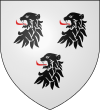History
Origins of the Clan
The name Buchan is derived from the district of Buchan, in the north east of Aberdeenshire and Banffshire. [1] The ancient Mormaerdom and Earldom of Buchan came into the hands of the Clan Comyn, but they later lost it after they were defeated by Robert the Bruce. [1] The title of Earl of Buchan then went to Alexander Stewart, Earl of Buchan, who was also known as the Wolf of Badenoch. [1] The geographical name of Buchan was used by notable inhabitants of the district even though they may not have had a provable connection to the Earls of Buchan. [1]
The historian, Black, lists one Ricardus de Buchan as a clerk to the bishopric of Aberdeen in 1207. [1] Before 1281 William Buchan held land in Aberdeen. [1] In 1296 Sir Thomas de Boghan appears in the Ragman Rolls giving homage to Edward I of England. [1] Sir Thomas's lands were around Edinburgh, and his seal includes an eight rayed figure which may represent the shining sun, which also forms part of the clan chief's crest. [1]
It is not known definitively when the Buchans gained their lands of Auchmacoy. [1] However, in 1446 Andrew Buchan of Achmakwy was amongst those appointed to settle the boundaries of the lands of St Peter's Hospital. [1] Auchmacoy is believed to have been in the possession of the family from the beginning of the 14th century. [1] However it was not until 1503 when Andrew Buchan, reckoned the second chief of Clan Buchan, received a charter for the lands from James IV of Scotland. [1]
17th century and Civil War
The Buchan Barons of Auchmacoy were staunch royalists and supporters of the House of Stuart. [1] Thomas Buchan who was the third son of chief James Buchan of Auchmacoy, was a professional soldier who fought in both France and Holland. [1] He served in Douglas's Scots Regiment that was raised for the king of France. [1] In 1686 he was commissioned as colonel in the Earl of Mar’s regiment by James VII of Scotland. [1] He later joined John Graham, 1st Viscount Dundee. [1] After Dundee was killed at the Battle of Killiecrankie in 1689 Buchan was appointed as commander-in-chief of all Jacobite forces in Scotland and received his commission from the king in Ireland. [1] General Buchan harried the enemy with his force of twelve hundred foot soldiers. [1] However, on 1 May 1690 he was surprised and defeated by a strong government force under General Hugh Mackay at the Battle of Cromdale. [1] Buchan however escaped and joined forces with the Clan Farquharson who encouraged him to take the offensive again and they marched from Abergeldie to the Mearns. [1] He was opposed by the Master of Forbes who had a strong force of cavalry, but Buchan dispersed his troops to give the appearance of numerical superiority and Forbes retreated to Aberdeen, causing panic in the city. [1] General Hugh Mackay and his forces then marched to intercept Buchan and as a result the Highlanders under Buchan began to drift away. [1]
18th century and Jacobite risings
Thomas Buchan went into exile in France but he later returned to fight at the Battle of Sheriffmuir in 1715. [1] He died in 1721, still in communication with the exiled royals. [1]
Modern history
James Buchan, fourteenth of Auchmacoy, was recognised as chief of the name by Lord Lyon, King of Arms in April 1830. [1] The title then passed to Louisa, his daughter. [1] The title then passed to her cousin, Sir Norman MacLeod Sinclair, 18th Earl of Caithness. [1] In 1913 he petitioned the Lord Lyon, taking the surname and arms of Buchan of Auchmacoy. [1] The Earl of Caithness's daughter, Lady Lucy Buchan married Sir Thomas Innes of Learney, who was the Lord Lyon in 1928. Their son was Sir Malcolm Innes of Edengight, also Lord Lyon. [1] His eldest daughter became the seventeenth of Auchmacoy and her son changed his name to Buchan in 1949 to be recognized by the Lord Lyon as chief of Buchans. [1]
Perhaps the most famous Buchan was John Buchan, 1st Baron Tweedsmuir, author of The Thirty-Nine Steps and Governor General of Canada.
Major General Ross Stuart Buchan, AO, was an Australian soldier. In his career, he served as a major on a tour in Vietnam and went on to become the General Officer Commanding Headquarters Training Command. During his Vietnam tour, a close friend, Major Peter Badcoe, was killed and subsequently posthumously awarded the Victoria Cross. The Sydney Morning Herald has a decent article online regarding his career. [2]
Following the passing of David Buchan in 2014, the title of Chief of Clan Buchan has passed to his son, Charles Buchan of Auchmacoy.
Septs
The clan has no official septs, but the following names have been linked to the Buchan region : [3] Basken/ Baskin, Bede, Buchan/ Bichan/ Bichen, Bonnieville, Boyne, Buck/ Buckie/ Bucky, Cawsell, Chapp, Chrystal, Chrystall, Clapperton, Coscrach/ Costie/ Costy, Cranach/ Crannach, Cruddon/ Cruden/ Crudon, Crystal/ Crystal/ Crystall, Fitchie/ Fitchy, Gammerie/ Gammery, Hardin/ Hardman/ Hardnan, Kermack, Leisk, Mac, Meason/ Merson, Mondie/ Mondy/ Mundie/ Mundy, Nible/ Niblo, Ogston/ Ogstone/ Ogstoun, Prince, Ratcliff/ Ratliff/ Rattcliff/ Rattliff, Runcie/ Runcy, Shakle, Tarves/ Tarvis, Teunion/ Teunon/ Tewnion/ Tinnon, Tucks, Wadsworth/ Wadsworther, West, Whammond/ Whyman/ Whymon, Willgook
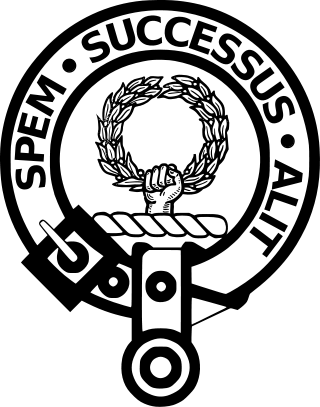
Clan Ross is a Highland Scottish clan. The original chiefs of the clan were the original Earls of Ross.

Alexander Stewart, Earl of Buchan, Alasdair Mór mac an Rígh, and called the Wolf of Badenoch, was the third surviving son of King Robert II of Scotland and youngest by his first wife, Elizabeth Mure of Rowallan. He was the first Earl of Buchan since John Comyn, from 1382 until his death. Alexander married the widowed Euphemia I, Countess of Ross, but they had no children. He did have a large family by his longtime mistress, Mairead inghean Eachainn. Alexander was Justiciar of Scotia for a time, but not an effective one. He held large territories in the north of Scotland before eventually losing a large part of them. Alexander is remembered for his destruction of the royal burgh of Elgin and its cathedral. His nickname was earned due to his notorious cruelty and rapacity, but there is no proof that it was used during his lifetime.
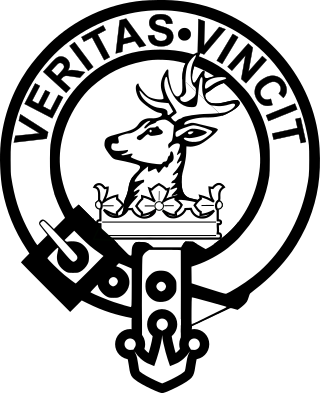
Clan Keith is a Highland and Lowland Scottish clan, whose Chief historically held the hereditary title of Marischal, then Great Marischal, then Earl Marischal of Scotland.

Clan Mackay is an ancient and once-powerful Highland Scottish clan from the far North of the Scottish Highlands, but with roots in the old Kingdom of Moray. They supported Robert the Bruce during the Wars of Scottish Independence in the 14th century. In the centuries that followed they were anti-Jacobite. The territory of the Clan Mackay consisted of the parishes of Farr, Tongue, Durness and Eddrachillis, and was known as Strathnaver, in the north-west of the county of Sutherland. However, it was not until 1829 that Strathnaver was considered part of Sutherland when the chief sold his lands to the Earls of Sutherland and the Highland Clearances then had dire consequences for the clan. In the 17th century the Mackay chief's territory had extended to the east to include the parish of Reay in the west of the neighbouring county of Caithness. The chief of the clan is Lord Reay and the lands of Strathnaver later became known as the Reay Country.

Clan Gunn is a Highland Scottish clan associated with lands in northeastern Scotland, including Caithness, Sutherland and, arguably, the Orkney Isles. Clan Gunn is one of the oldest Scottish Clans, being descended from the Norse Jarls of Orkney and the Pictish Mormaers of Caithness.

Clan Sutherland is a Highland Scottish clan whose traditional territory is the shire of Sutherland in the far north of Scotland. The chief of the clan was also the powerful Earl of Sutherland, however in the early 16th century this title passed through marriage to a younger son of the chief of Clan Gordon. The current chief is Alistair Sutherland who holds the title Earl of Sutherland.

Clan Sinclair is a Highland Scottish clan which holds the lands of Caithness, the Orkney Islands, and the Lothians. The chiefs of the clan were the Barons of Roslin and later the Earls of Orkney and Earls of Caithness. The Sinclairs are believed to have come from Normandy to England during the Norman conquest of England, before arriving in Scotland in the 11th century. The Sinclairs supported the Scottish Crown during the Scottish–Norwegian War and the Wars of Scottish Independence. The chiefs were originally Barons of Roslin, Midlothian and William Sinclair, 1st Earl of Caithness and Baron of Roslin founded the famous Rosslyn Chapel in the 15th century. He split the family lands, disinheriting his eldest son from his first marriage, William, who inherited the title of Lord Sinclair, instead giving the lands of Caithness to the second son from his second marriage, William Sinclair, 2nd Earl of Caithness, in 1476, and the lands at Roslin to his eldest son from his second marriage, Sir Oliver Sinclair. In the 16th century the Sinclairs fought against England during the Anglo-Scottish Wars and also feuded with their neighbors the Clan Sutherland. During the Jacobite rising of 1715 the Sinclairs supported the Jacobite cause, but during the Jacobite rising of 1745, while the clan largely had Jacobite sympathies, their chief, the Earl of Caithness, supported the British-Hanoverian Government. The current chief is Malcolm Sinclair, 20th Earl of Caithness.

Alexander Comyn, 2nd Earl of Buchan was a Scoto-Norman magnate who was one of the most important figures in the 13th century Kingdom of Scotland. He was the son of William Comyn, jure uxoris Earl of Buchan, and Marjory, Countess of Buchan, the heiress of the last native Scottish Mormaer of Buchan, Fergus. He was the chief counsellor of Alexander III, King of Scots for the entire period of the king's majority and, as Scotland's leading magnate, played a key role in safeguarding the independence of the Scottish monarchy. During his long career, Alexander Comyn was Justiciar of Scotia (1258–89), Constable of Scotland (1275–89), Sheriff of Wigtown (1263–66), Sheriff of Dingwall (1264–66), Ballie of Inverie and finally, Guardian of Scotland (1286–89) during the first interregnum following the death of Alexander III. In 1284 he joined with other Scottish noblemen who acknowledged Margaret of Norway as the heiress to King Alexander. He died sometime after 10 July 1289.
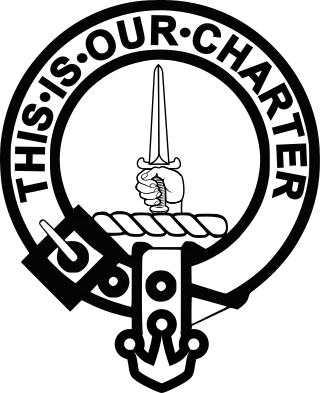
Clan Charteris is a Scottish clan of the Scottish Lowlands.

Clan Macnab is a Highland Scottish clan.
Clan Strachan is a Scottish clan originating from the barony of Strachan, in Aberdeenshire. The clan does not have a chief, therefore it is considered by Court of the Lord Lyon and the Stand Council of Scottish Chiefs as an Armigerous clan.
Donald Mackay, 1st Lord Reay, 14th of Strathnaver was a Scottish soldier and member of Parliament. He played a prominent role in the Thirty Years' War, raising a regiment of 3,000 men, which served in both the Danish and Swedish forces. He was later an unwilling Covenanter. He was the fourteenth chief of Clan Mackay, a Highland Scottish clan.

Clan Kirkpatrick is a Lowland armigerous Scottish clan. There are several variations of the Kirkpatrick name: Kilpatric, Kilpatrick, and Gilpatrick. The names Kirkpatrick and Kilpatrick may have been interchangeable at one time. The clan is recognised by the Court of the Lord Lyon, however the clan does not currently have a chief so recognised. The surname Kirkpatrick is also a recognized sept of Clan Douglas and Clan Colquhoun.
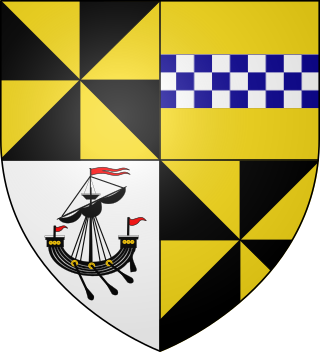
The Battle of Altimarlach was a Scottish clan battle that took place on 13 July 1680, near Wick, Caithness, Scotland. It was fought in a dispute between Sir John Campbell of Glenorchy and George Sinclair of Keiss over who had the right to the title and lands of the Earl of Caithness. The battle was fought between men of the Clan Campbell and Clan Sinclair. Campbell of Glenorchy won a decisive victory in the battle, but Sinclair of Keiss later turned to the law and was awarded the title of Earl of Caithness.

Clan Cumming, also known as Clan Comyn, is a Scottish clan from the central Highlands that played a major role in the history of 13th-century Scotland and in the Wars of Scottish Independence. The Clan Comyn was once the most powerful family in 13th-century Scotland, until they were defeated in civil war by their rival to the Scottish throne, Robert the Bruce.
Angus Du Mackay, 7th of Strathnaver was the seventh chief of the Clan Mackay, a Highland Scottish clan. He is recorded in the 15th-century Scottish chronicle, Scotichronicon, as Enneas-en-Imprissi meaning Angus the Absolute due to his power of commanding 4000 men.
The Murrays of Aberscross were a minor noble Scottish family who were seated at Aberscross Castle, in the county of Sutherland, Scotland. The Murrays in Sutherland are recorded specifically as a clan in two Acts of the Scottish Parliament of the 16th century.
Thomas Buchan (c.1641–1724) was a Scottish professional soldier from a Catholic family in Aberdeenshire who served in the armies of France, the Netherlands and Scotland. He remained loyal to James II after the 1688 Glorious Revolution and participated in the War in Ireland before taking command of Jacobite forces in Scotland in February 1690. After the Highland chiefs submitted to William III in early 1692, he was given safe passage to France and later allowed to return home in 1703. He maintained links with the Stuart exiles and played a small role in the 1715 Rising but escaped punishment and died at Fyvie in 1724.
Iye Du Mackay, 12th of Strathnaver, was the chief of the Clan Mackay, a Highland Scottish clan, from 1550 to 1572.

The Mackays of Scoury were a minor noble Scottish family and a branch of the ancient Clan Mackay, a Highland Scottish clan. They were seated at Scourie Castle, in Scourie, in the parish of Eddrachillis, county of Sutherland. However, Scourie was part of the Mackay chief's province of “Strathnaver” until it was sold to the Earl of Sutherland in 1829.
